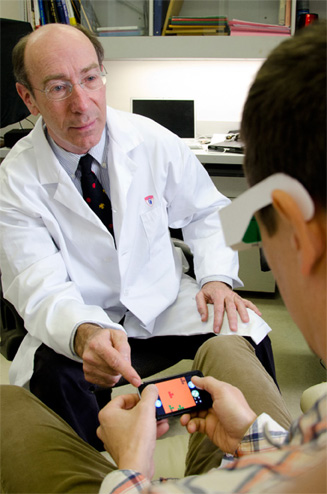By Paddy Kamen
Science has once again leapt from a mindset of stagnation to a world of discovery, and a Canadian vision scientist has led the way. In an exciting development, Dr. Robert Hess and his team of international collaborators demonstrated that both eyes can learn to work together for improved vision when one of them is amblyopic. “This was previously thought impossible,” comments Hess, director of the Research Department of Ophthalmology at the Research Institute of the McGill University Health Centre (RI-MUHC).
The research was recently published in the prestigious journal Current Biology, with Hess as the senior author. The key scientific principle that underlies the research is the notion of brain plasticity: the idea that the brain can change at any age in response to experience. And so, Hess uses the language ‘the amblyopic brain’ as opposed to ‘the amblyopic eye’.
“We have known for some time that the amblyopic eye is quite normal and the problem is in the visual processing regions of the brain. But the old way of thinking was that the amblyopic eye learns ‘bad habits’ early in the child’s development and that these habits are only amenable to change through patching the good eye. Thus, the so-called ‘lazy eye’ has been forced to work harder or better for hundreds of years. This has been the main ‘treatment’ for amblyopia and it has serious limitations.”
Patching helps less than half the time, says Hess. “When it does work, it can improve vision quite a bit, and even get the vision to almost normal. But patching doesn’t usually get the two eyes working together. Restricting children to operating in a low vision world can be dangerous to their safety and it causes stress. It also stresses the parents as they try to keep the kid wearing the patch.”
Hess knows from personal experience how stressful patching an eye can be. As part of an experiment he patched one of his eyes for four days. “It had a devastating effect on me,” he explains. “While it disrupts your 3D vision, reduces the visual field and makes one clumsy, the main problem was that I became depressed and the world looked dull and boring. After four days, my family was begging me to take off the patch. I certainly wouldn’t have predicted such a dramatic effect.”
Vision scientists have long assumed that binocular vision or stereopsis is not terribly important, asserts Hess. Now he knows that it is, in fact, essential to a sense of well-being. “One can get good at compensating, but it takes more trial and error to learn simple tasks and this can affect self-esteem in children. There is more research coming out on hand-eye coordination and the importance of stereopsis. Three-dimensional vision gives life a richness that we take for granted.”
Hess’ team began thinking about amblyopia in a different way, hypothesizing that the amblyopic eye is not passive by nature but is instead actively suppressed by the stronger eye. “In the visual areas of the brain, signals from the good eye turn off signals from the other eye, in order to avoid confusion. We think this happens in infancy or early childhood as a reaction to an eye that is not straight or in which the vision is poor. The two eyes should be working together but instead one eye dominates, turning off the brain connection in the other eye and leading to a loss of function. So we thought, why not try to get the eyes working together?”
Hess learned that visual contrast is the determining factor in the ability of the strong eye to dominate. He explains: “We arranged viewing conditions that reduced contrast to the stronger eye. Using the popular video game Tetris, we placed head-mounted goggles on the subjects that presented aspects of the game dichoptically, where the weaker eye saw the geometric shapes falling and the stronger eye saw only the ground-plane objects. The information was thus distributed between the two eyes in a complementary manner. We lowered the contrast in the stronger eye, until we found a level at which it didn’t suppress the amblyopic eye. Over time we increased the contrast to the stronger eye until it approached normal vision, while at the same time not suppressing the amblyopic eye.”
This was a controlled, crossover study in which one group of subjects played the game monocularly with the weaker eye (having the stronger eye patched), and the other group played the game dichoptically. After two weeks, the dichoptic group showed a dramatic improvement in the vision of the weaker eye (three lines on the letter chart), and over half of the subjects regained 3-D depth perception by a factor of 3 in a Randot test. When the monocular patching group, which had showed only a moderate improvement, was switched to the new dichoptic training, their vision also improved dramatically.
A large clinical trial with children, comparing this technique to patching is in the planning stages.
“We already know that it works with the younger population but a formal controlled study is essential to prove efficacy,” says Hess. “If our method comes out on top, it can take the place of patching, giving an improved quality of vision to millions of children, and helping them to enjoy the richness of life and to learn more easily.”








